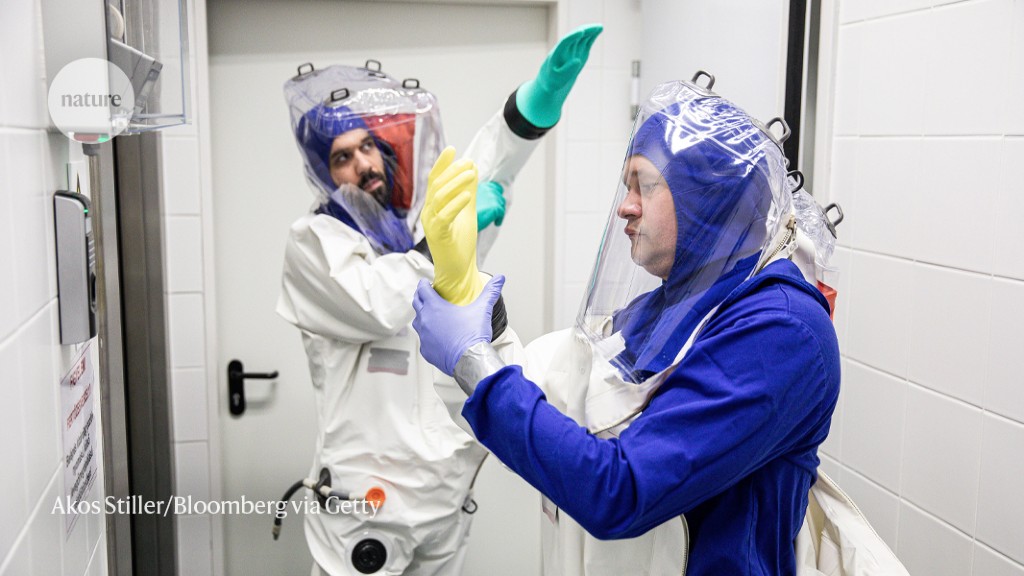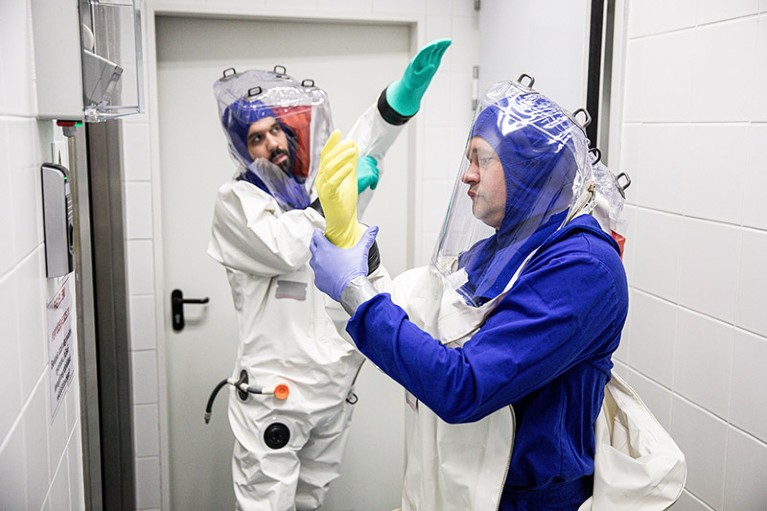The lack of high-security labs in some regions became apparent during the pandemic.Credit: Akos Stiller/Bloomberg via Getty
In the wake of the COVID-19 pandemic, plans are afoot to build more than 40 high-level biosafety laboratories around the world, including in India, the Philippines and Singapore. Investments in biosafety labs often follow major epidemics, but some researchers are concerned about the growing number of facilities that will handle some of the world’s most dangerous pathogens.
Some scientists worry about the huge cost of maintaining biosafety-level-3 (BSL-3) and BSL-4 facilities, whereas others fear the risks posed by these labs, such as the possibility of creating pathogens that are more dangerous or of microorganisms escaping.
But researchers in the countries that plan to build these laboratories say they are needed. The lack of high-security labs in some regions became particularly apparent during the pandemic, because work on the live virus that causes COVID-19, SARS-CoV-2, must be done at a BSL-3 or BSL-4 facility.
“The pandemic exposed the weakness of health systems worldwide in recognizing and responding to emerging threats in public health,” said Bharati Pawar, India’s minister for health and family welfare, at a ceremony to mark the start of construction for one of the nation’s new BSL-3 labs in Bengaluru last month. “In this light, the critical element of any preparedness programme is lab preparedness,” she said.
Around the world
India’s plans are among the most ambitious. The country is in the process of building five BSL-3 facilities and is planning at least another nine more. Four institutions have also said they will construct BSL-4 labs with the highest level of containment, too. India currently only has one such facility that is operational. And the government has committed to building four new national institutes of virology, two of which will also eventually handle BSL-4 pathogens.
BSL-3 laboratories are designed so that scientists can safely work with potentially lethal and inhalable pathogens in a contained environment. Experiments are conducted in sealed workspaces in which the air is filtered and not recirculated, and the entrance to the facility is typically secured by self-closing doors. BSL-4 facilities, in which researchers work with fatal pathogens that can spread through aerosols, and for which vaccines or treatments are lacking or limited, require extra security measures. These labs are isolated from other sections of a building and have a dedicated air supply, and researchers change clothes and shower before entering and leaving the premises.
The pandemic has raised public awareness of emerging diseases and the need for labs, creating a favourable environment for these investments, says Pragya Yadav, a virologist who heads the BSL-4 facility at the National Institute of Virology in Pune. A country India‘s size needs more high-containment facilities, she says.
Elsewhere in Asia, Kazhakhstan, Singapore and the Philippines have announced plans to build their first BSL-4 facilities. Beyond the region, the United States has committed to adding another BSL-4 lab to its existing group of about a dozen maximum-containment facilities. And Russia announced last year that it will build 15 BSL-4 labs, although details are scant.
Since the COVID-19 pandemic began, plans to build 27 BSL-4 labs have been announced worldwide, say Gregory Koblenz, a biodefense researcher at George Mason University in Arlington, Virginia, and Filippa Lentzos, a biosecurity researcher at King’s College London, who have tracked the number and distribution of BSL-4 facilities globally. “These will likely take several years to design, build and commission,” says Lentzos.
Endemic diseases
Researchers hope that the new biosafety labs will support more research into drugs and vaccines, especially for infectious diseases that affect these countries, including tuberculosis, dengue virus and Kyasanur forest disease, a viral haemmorrhagic fever spread by ticks. “It is important to have the lab capacity to study endemic diseases,” says Kathrin Summermatter, who operates a BSL-3 lab at the University of Bern.
The new labs will improve working conditions for researchers, too. Before the pandemic, Raju Mukherjee, a biochemist at the Indian Institute of Science Education and Research in Tirupati, and his students, used to travel for five hours by bus to the nearest BSL-3 lab, in Bengaluru, several times a year. He would spend about a month there at a time — adding up to four months a year away from his family — to study drug resistance in Mycobacterium tuberculosis, which causes tuberculosis, and develop treatments. Mukherjee is one of five researchers in India to receive government funding to build a new BSL-3 facility, and construction in Tirupati should start by March 2023.
Super expensive
But some researchers question the need for so many extra BSL-3 and BSL-4 labs and note the hefty cost of maintaining them.
Illich Mombo, a virologist at the International Centre for Medical Research of Franceville in Gabon, says that roughly 10% of his lab’s budget goes on experiments, whereas around 90% is spent on checking, maintaining and repairing the facility. When instruments break, they cost a lot to fix and there are no trained technicians in the region. Researchers are sometimes sent to work elsewhere, says Mombo.
Thomas Ksiazek, a virologist who heads the high-containment operations at Galveston National Laboratory in Texas, a BSL-4 facility, says that his team’s lab receives close to $12 million a year from the National Institute of Allergy and Infectious Diseases just for maintenance and operations, some $2 million of which is spent on 24-hour security. And about $2 million is required to power the ventilation, heating and air conditioning, as well as to operate the BSL-3 portion of the lab.
Rohani Navarro, a veterinarian at the Philippines’ National Institute of Molecular Biology and Biotechnology in Manila, says that she and her colleagues are constantly writing grant applications just to maintain their BSL-3 operations. She says the annual certification, which involves a thorough safety review, costs some $40,000. “High-containment facilities can become like a white elephant that isn’t used.”
Some researchers also worry that having more of these labs will increase the risks associated with them, including of workers being infected. Scientists say labs often struggle to find well-trained staff to run high-containment facilities. Kim Sales, who researches health policy and health systems at the non-profit organization Alliance for Improving Health Outcomes in Manila, conducted a survey of lab practices in the Philippines, which plans to build a BSL-4 lab. Sales found that biosafety officers had only a weak understanding of biosafety.
High-risk experiments
More labs could also lead to more high-risk research such as gain-of-function studies, in which pathogens are sometimes modified, which could make them more dangerous to people, says Lentzos.
A large body of evidence suggests that SARS-CoV-2 jumped to humans from wild animals, probably at a live-animal market in Wuhan, China, but some scientists say they cannot exclude the possibility that the pandemic started with an enhanced virus that escaped from a lab, raising broader concerns about the risks of gain-of-function research. Wuhan is also home to the Wuhan Institute of Virology, a BSL-4 lab.
But some scientists say that new biosafety labs could lead to better safety practices. “These laboratories help researchers work more safely than they could without them,” says Gigi Gronvall, a biosecurity scientist at Johns Hopkins University in Baltimore, Maryland. “Assuming that people are trained well and equipment is updated, I am not concerned by the array of BSL-3 laboratories.”






More News
I study artefacts left in prehistoric caves
How artificial intelligence is helping to identify global inequalities
Tackling ‘wicked’ problems calls for engineers with social responsibility